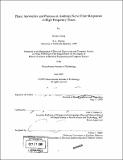| dc.contributor.advisor | John J. Guinan, Jr. | en_US |
| dc.contributor.author | Cheng, Holden | en_US |
| dc.contributor.other | Massachusetts Institute of Technology. Dept. of Electrical Engineering and Computer Science. | en_US |
| dc.date.accessioned | 2006-09-28T15:04:17Z | |
| dc.date.available | 2006-09-28T15:04:17Z | |
| dc.date.copyright | 2005 | en_US |
| dc.date.issued | 2005 | en_US |
| dc.identifier.uri | http://hdl.handle.net/1721.1/34114 | |
| dc.description | Thesis (S.M.)--Massachusetts Institute of Technology, Dept. of Electrical Engineering and Computer Science, 2005. | en_US |
| dc.description | Includes bibliographical references (leaves 39-40). | en_US |
| dc.description.abstract | Phase reversals and phase plateaus have been found in studies that measure motion of the basilar membrane (BM) at the base of the cochlea in response to high-level sounds above the characteristic frequency (CF). In contrast, such patterns have not been found in responses of auditory-nerve fibers (ANF) from the base of the cochlea, primarily because these ANFs do not have synchronized responses to high-frequency tones. We sought counterparts to the BM responses in auditory nerve fibers (ANF) by using a new method that extracts phase information from beat-producing multi-tone stimuli. The method can determine the relative phases of ANF responses to high-frequency tones by measuring the phases of low-frequency beats and from these beats, reconstructing the relative phases of the original tone response. We also used amplitude modulated (AM) tones at high sound levels. The data collected suggest that the new beat-producing phase-analysis method is effective at tip and tail regions of the ANF tuning curves. However, this method has low success in measurements at frequencies above CF due to low signal-to-noise ratios and large distortion products in the ANF responses. AM tones, however, were more successful and showed significant evidence of a phase plateau at high levels and at frequencies well above the fiber's CF. | en_US |
| dc.description.abstract | (cont.) Thus this plateau response appears to be present in ANF firings as well as BM motion. ANF responses to multi-tone stimuli presented above CF and at moderate level resulted in an anomalous negative group delay. Presuming that the multi-tone method yields a valid picture of the original high frequency phase responses we speculate that the anomaly is produced by complex interactions among two or more response components at the above-CF region of the ANF tuning curve. | en_US |
| dc.description.statementofresponsibility | by Holden Cheng. | en_US |
| dc.format.extent | 40 leaves | en_US |
| dc.format.extent | 1814833 bytes | |
| dc.format.extent | 1816397 bytes | |
| dc.format.mimetype | application/pdf | |
| dc.format.mimetype | application/pdf | |
| dc.language.iso | eng | en_US |
| dc.publisher | Massachusetts Institute of Technology | en_US |
| dc.rights | M.I.T. theses are protected by copyright. They may be viewed from this source for any purpose, but reproduction or distribution in any format is prohibited without written permission. See provided URL for inquiries about permission. | en_US |
| dc.rights.uri | http://dspace.mit.edu/handle/1721.1/7582 | |
| dc.subject | Electrical Engineering and Computer Science. | en_US |
| dc.title | Phase anomalies and plateaus in auditory nerve fiber responses to high-frequency tones | en_US |
| dc.type | Thesis | en_US |
| dc.description.degree | S.M. | en_US |
| dc.contributor.department | Massachusetts Institute of Technology. Department of Electrical Engineering and Computer Science | |
| dc.identifier.oclc | 67617507 | en_US |
